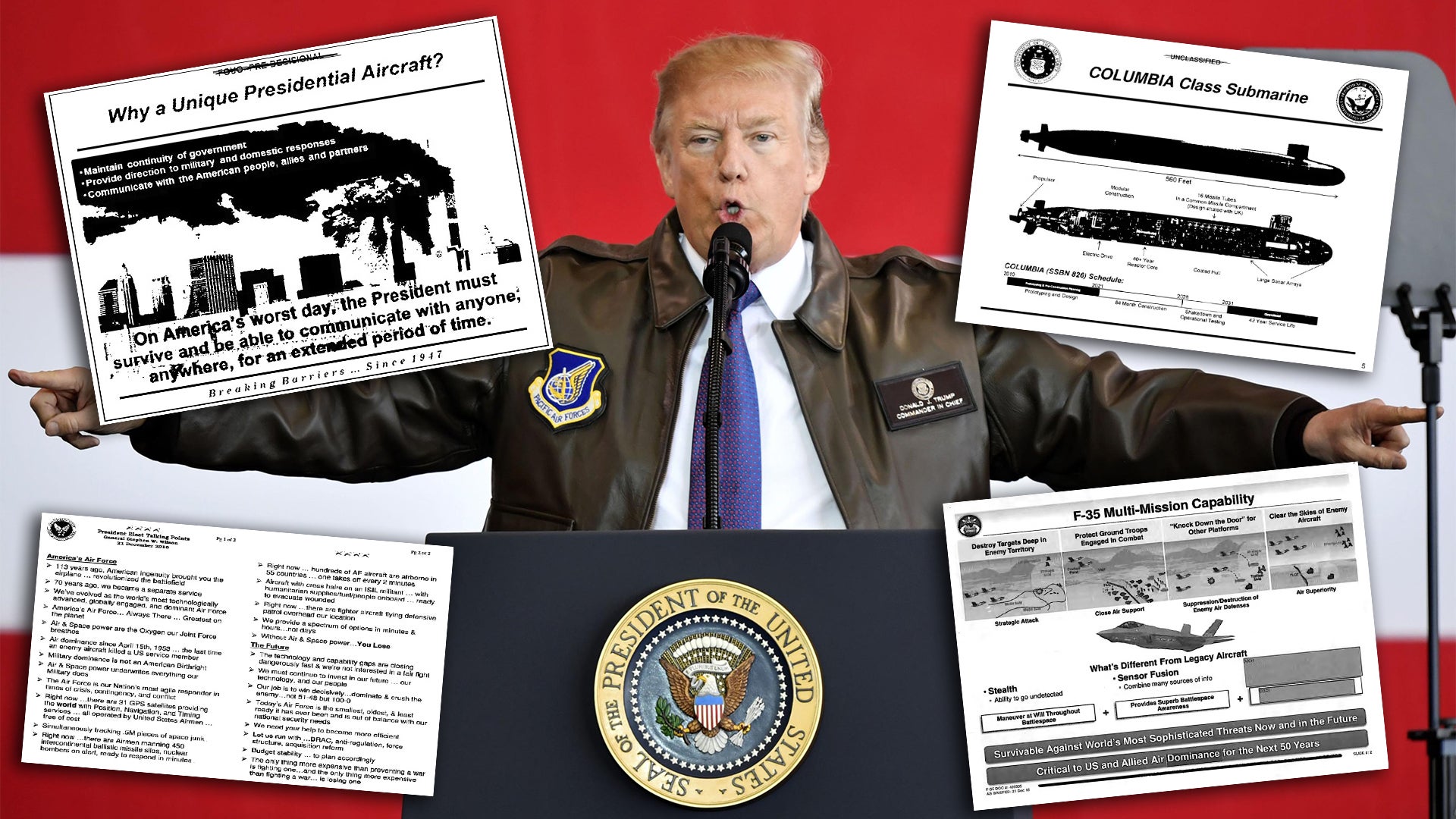Just shy of a month before his inauguration in 2017, then-President-Elect Donald Trump held a series of meetings with senior officials from the U.S. Air Force and other branches of the U.S. military, as well as executives from Lockheed Martin and Boeing, at his Mar-a-Lago club in Florida. At the time, reports said that the primary topics of discussion were the F-35 Joint Strike Fighter and the Air Force One replacement effort, programs Trump criticized the cost of before and after the meetings, but which he began to soften on in the months afterward. Now, thanks to the Freedom of Information Act, we have more details about exactly what information Trump received from the military briefers, including that he received a presentation on the U.S. Nuclear Triad, as well.
On Dec. 21, 2016, Trump met with multiple flag officers from the U.S. Air Force and the U.S. Navy. The War Zone obtained a total of three unclassified briefings and one set of unclassified talking points through FOIA. U.S. Air Force Lieutenant General Chris Bogdan, then head of the F-35 Joint Program Office, briefed the President-Elect on the stealthy fighter jet and U.S. Air Force General Carlton Everhart, chief of Air Mobility Command, provided an overview of the Air Force One recapitalization program. U.S. Air Force Lieutenant General Jack Weinstein, Deputy Chief of Staff for Strategic Deterrence and Nuclear Integration, and U.S. Navy Vice Admiral David Johnson, the principal military deputy for the Assistant Secretary of the Navy Research, Development and Acquisition, jointly briefed Trump on the Nuclear Triad. U.S. Air Force Vice Chief of Staff General Stephen Wilson prepared talking points for the meeting. Bogdan, Everhart, Johnson, and Weinstein have all since retired.
“America’s Air Force … Always There … Greatest on the planet,” one of Wilson’s talking points reads. This looks very much like an appeal to Trump’s heavy focus on American “greatness” on the campaign trail, including his signature slogan, “Make America Great Again.”
“Without Air & Space power … You Lose,” another one declares with the second part bolded for emphasis, again seeming to speak to the president-elect’s campaign trail promises to reinvigorate America’s military capabilities and readiness. “Our job is to win decisively … dominate & crush the enemy … not 51-48 but 100-0.”
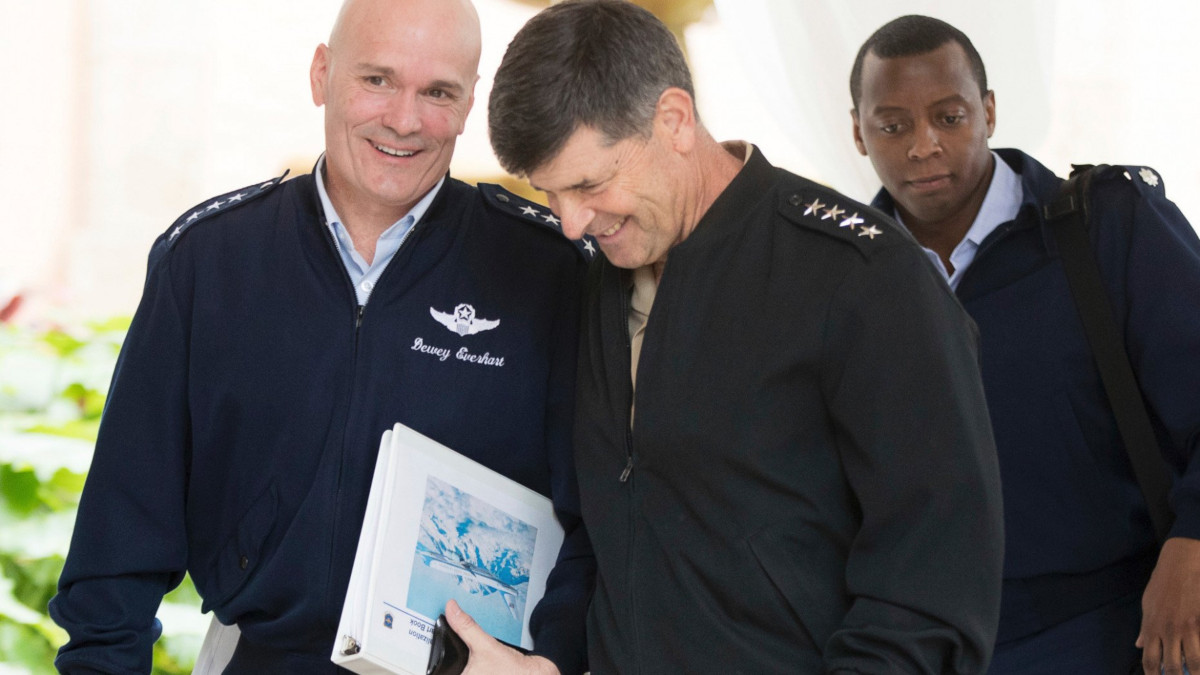
Wilson’s talking points, which you can see below in their entirety, contain a number of other relatively common refrains from the U.S. military at the time, many of which continue to be general talking points to this day. “The technology and capability gaps are closing dangerously fast & we’re not interested in a fair fight,” one says. “Today’s Air Force is the smallest, oldest, & least ready it has ever been and is out of balance with our national security needs.”
The talking points otherwise include a fair amount of mundane details and end with a plea for stable defense budgets going forward, something the U.S. military as a whole had been calling for after years of short-term spending bills from Congress, also known as Continuing Resolutions. It also implores Trump to “Let us run with … BRAC [Base Realignment and Closure], anti-regulation, force structure, [and] acquisition reform.”
The Trump Administration, with help from a Republican-controlled Congress, would succeed in passing the first full defense budget in a decade, covering the 2019 Fiscal Year, in September 2018. There were also reports that he initially delegated a significant amount of decision making authority to former Secretary of Defense James Mattis. Trump forced Mattis out in December 2018 after the two men disagreed over the President’s desire to withdraw all U.S. forces from Syria.
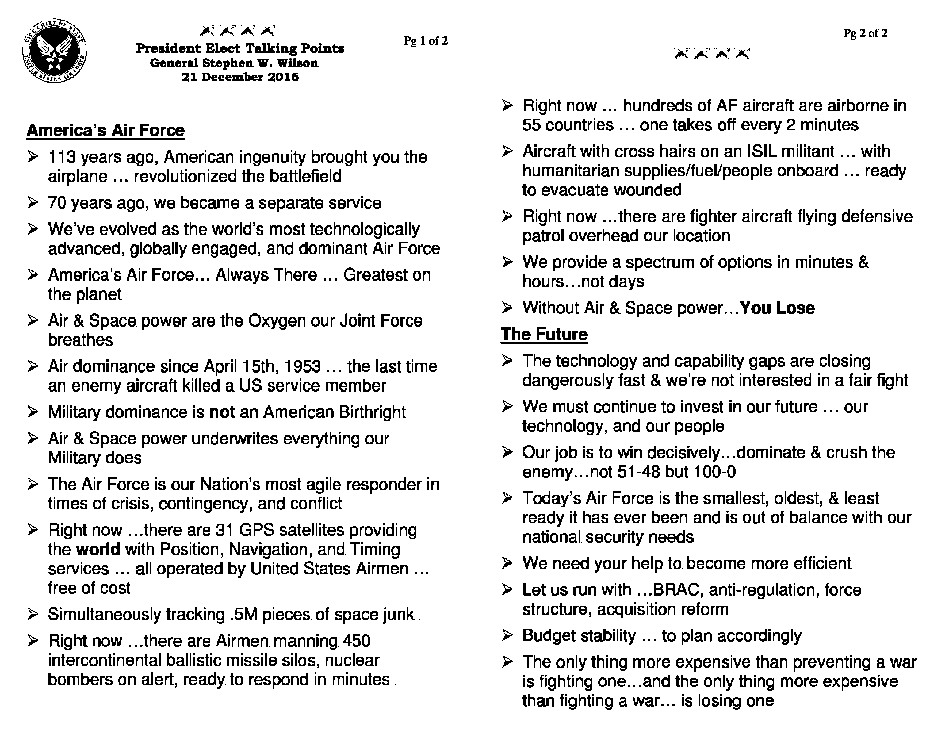
Wilson undoubtedly wanted to give his compatriots the best possible start to what had the potential to be a contentious meeting.
The F-35
Trump had slammed the F-35 program multiple times on the campaign trail, decrying it as a waste of money and just “not a very good” airplane.
“The F-35 program and cost is out of control,” Trump Tweeted out on Dec. 12, 2016, a little over a week before his meetings at Mar-a-Lago. “Billions of dollars can and will be saved on military (and other) purchases after January 20th.”
To his credit, Lieutenant General Bogdan’s presentation is one of the most candid official assessments of the F-35 program to ever become public. The briefing starts out with two slides highlighting well-established talking points about the F-35’s feature set, especially its electronic warfare and sensor fusion capabilities, and a note about the array of allies involved in the program.
“Critical to U.S. and allied air dominance for the next 50 years,” a line at the bottom of the first slide reads. “Big, complicated program with significant allied participation,” a similar chyron notes at the bottom of the second.

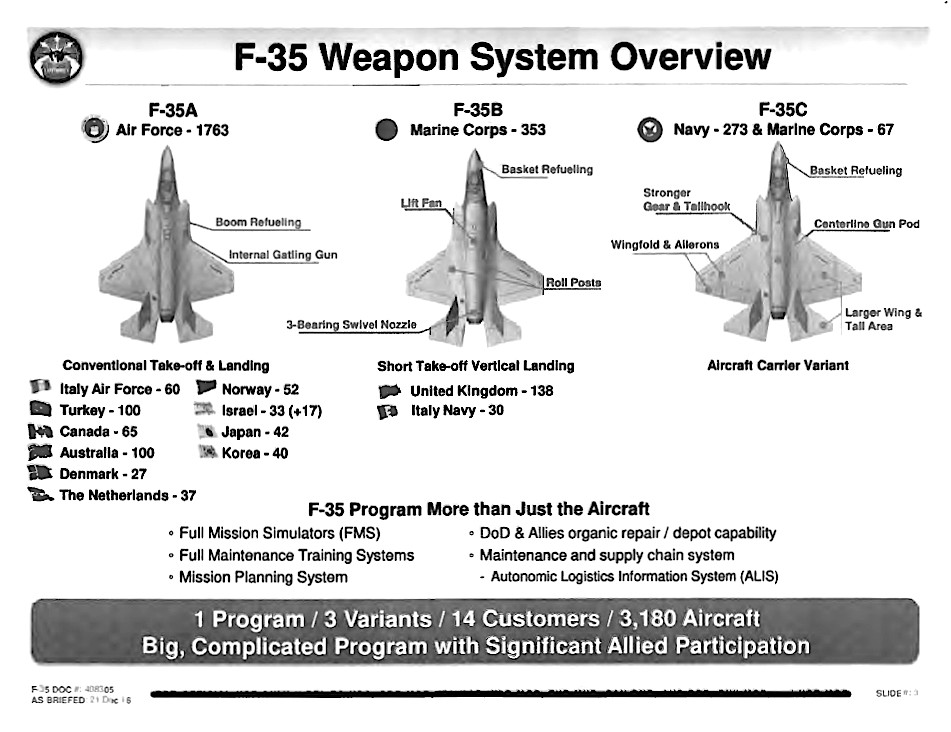
But the third slide, covering the program’s history, efficiently uses space to catalog a host of serious missteps and mistakes in its execution up to that point. It mentions the delay over the F-35B weight issues, the solution to which may have subsequently caused additional problems, and that the decision to begin serial production in 2007 was premature. The entry for 2009 shows that basically everything that could go wrong for the program, did go wrong.
Bodgan’s briefing goes even further to say that government intervention in 2011, which led to an effective rebooting of the program with a new schedule and cost estimates, offered a “marked improvement, but not perfect.” The bottom of this slide says, without caveat “Difficult to overcome a troubled past, but program is improving.”
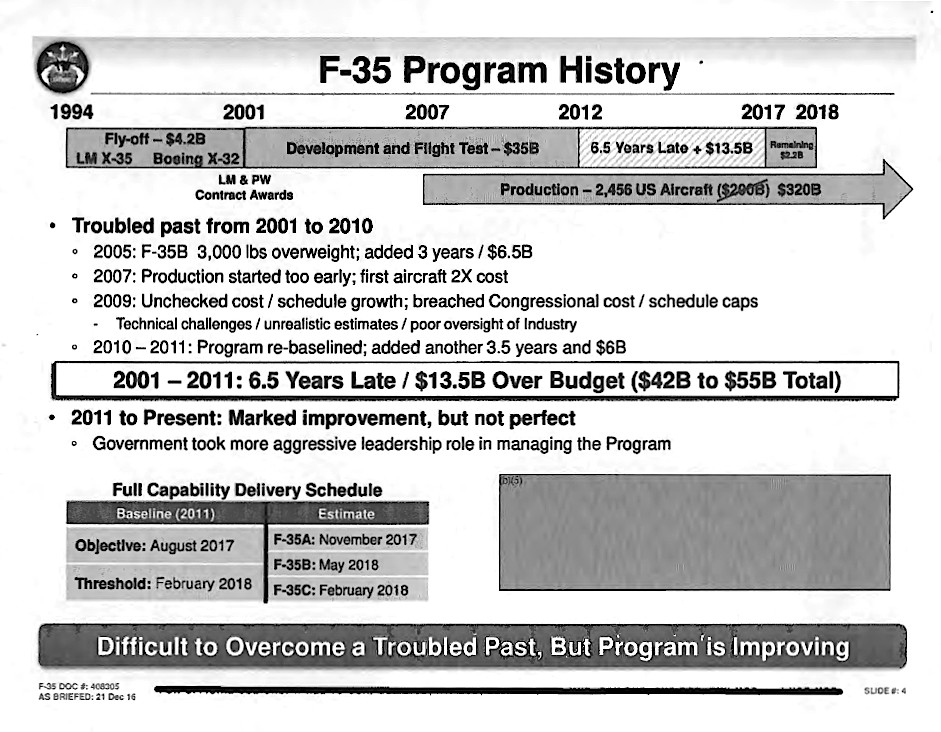
The program history slide included a box redacted for being “pre-decisional,” suggesting that there are still more granular parts of the F-35 program schedule that are subject to change. These kinds of redactions continue onto the final slide, which covers costs. The unit price estimates for the F-35A for production lots 10 through 13 are redacted, even though Lockheed Martin has released its own data and cost estimates for production well beyond the timeframe in the chart in Bogdan’s 2016 briefing.
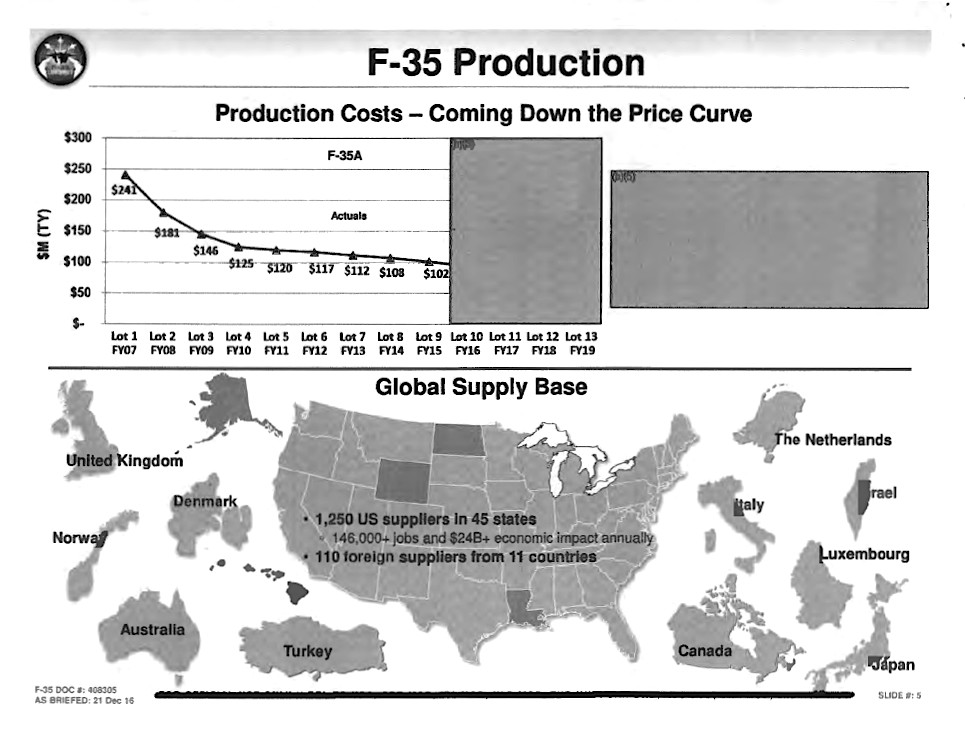
If Trump’s Tweeting is anything to judge by, the F-35 briefing fell flat, or may have even confirmed his presuppositions. On Dec. 22, 2016, the day after, he Tweeted out “Based on the tremendous cost and cost overruns of the Lockheed Martin F-35, I have asked Boeing to price-out a comparable F-18 Super Hornet!”
This attitude, of course, didn’t last forever. It seems in hindsight like it may have been an attempt at a ruse to try to put pressure on Lockheed Martin to offer a better price.
“We’re just beginning – it’s a dance,” Trump had told reporters outside Mar-a-Lago after the meetings on Dec. 21, 2016. “It’s a little bit of a dance. But we’re going to get the costs down and we’re going to get it done beautifully.”
Both Lockheed Martin and the Air Force did work hard to drive down the unit prices and Trump’s attitude toward the F-35 has changed dramatically, to put it mildly. There are still very serious concerns about how much it will cost to actually sustain the F-35s in the decades to come, but the President has clearly become enamored with the Joint Strike Fighters, which he often touts as literally “invisible.”
Air Force One
Prior to the meeting at Mar-a-Lago, Trump had publicly complained about the cost of buying new Air Force One’s. On Dec. 6, 2016, he had publicly called for canceling the program entirely over its $4 billion price tag.
“Boeing is building a brand new 747 Air Force One for future presidents, but costs are out of control, more than $4 billion,” he Tweeted. “Cancel order!”
That was the environment General Everhart was walking into to make his own briefing about the Air Force One replacement program. The officer got straight to the point of how critical it is to have these presidential planes and why they invariably cost so much. The very first two slides focus entirely on how President George W. Bush rode on one of the existing VC-25A planes in the immediate wake of the 9/11 terrorist attacks.
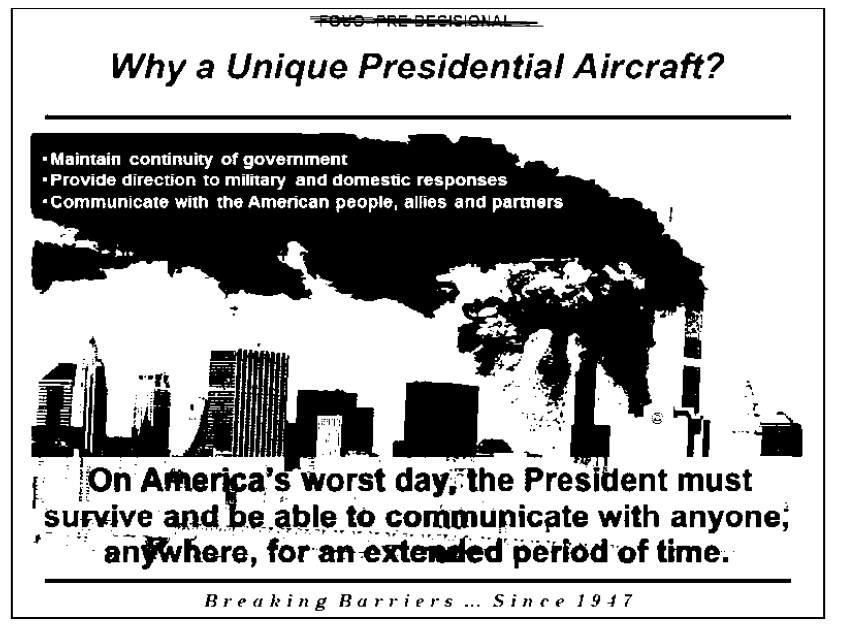
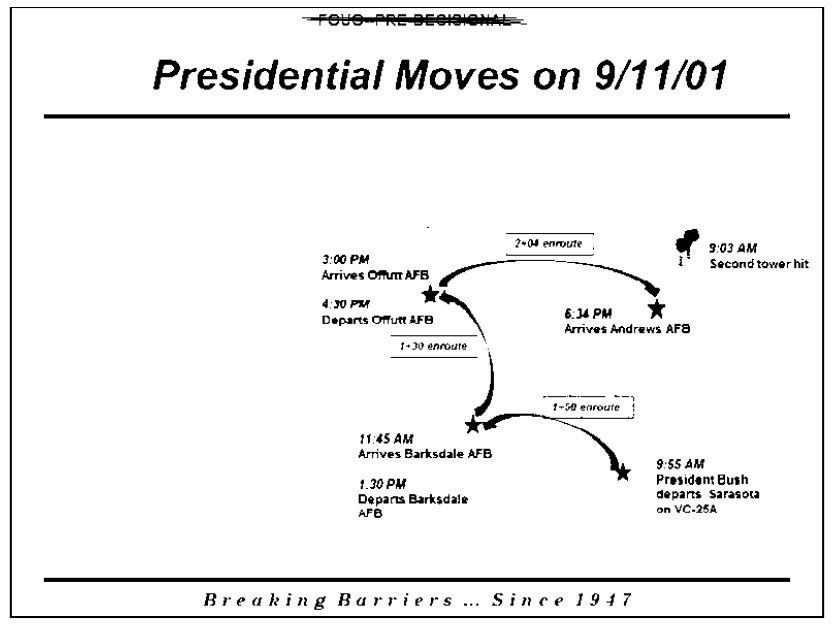
The Air Force included Everharts talking points for this briefing in the FOIA release, though the bulk of them are redacted. It does note that he stressed when talking about the specific features of the future 747-8i-based VC-25B aircraft that one engine out on a four-engine plane meant “land as soon as practical,” while one engine out on a two-engine plane meant “land as soon as possible.” Trump had regularly used his own personal twin-engine Boeing 757, nicknamed Trump Force One, on the campaign trail.
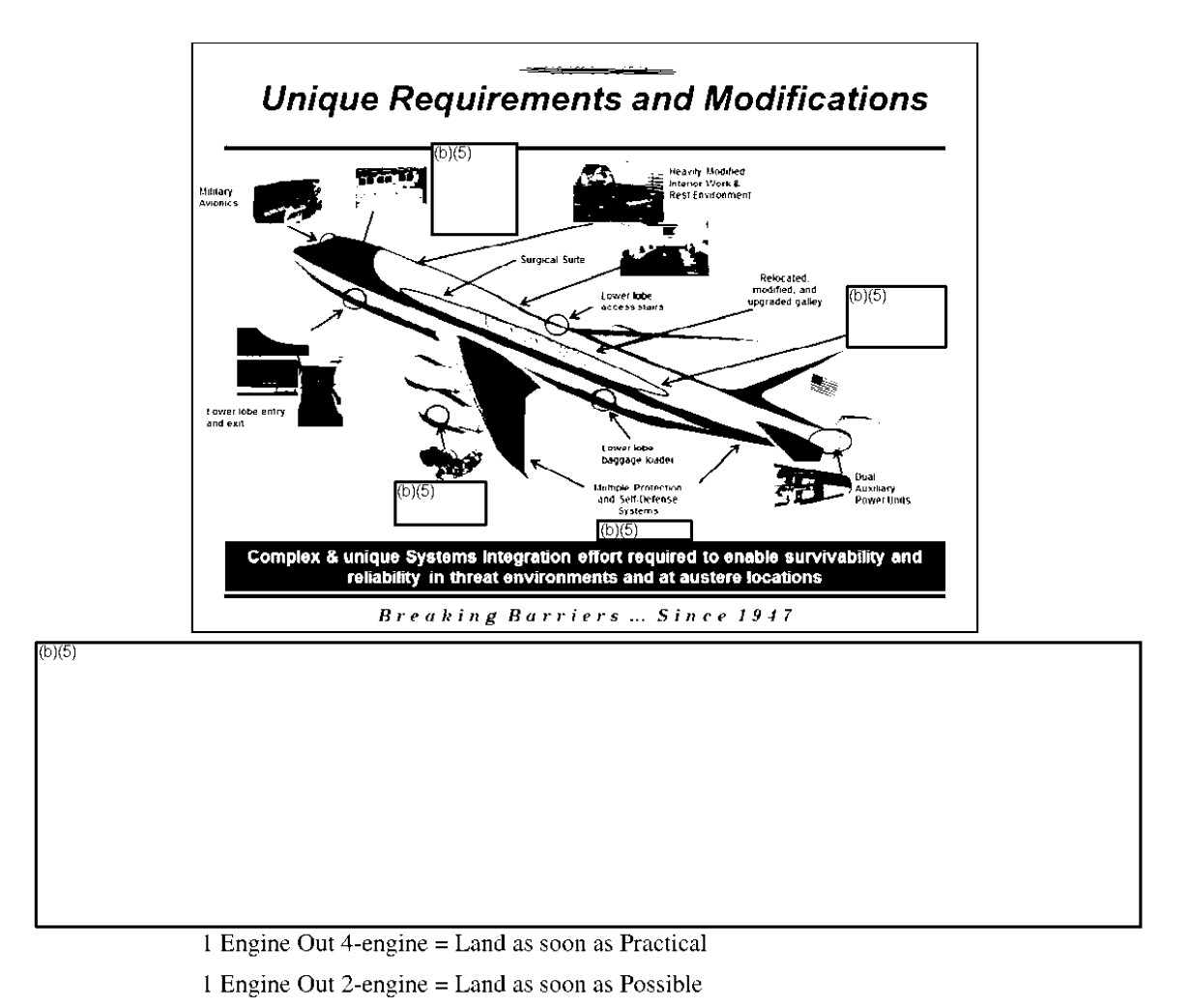
The slide on the program’s cost estimates, which remain the subject of significant controversy, is redacted entirely, though many of the talking points remain. Curiously, the Air Force appeared to argue that what it was doing at the time was in line with the acquisition of the two VC-25A aircraft in the 1980s and the sustainment and upgrading of those aircraft afterward. The VC-25As, “including costs associated with major upgrades performed after delivery,” would have cost $3.7 billion in Fiscal Year 2017 dollars, according to the briefing.
But if this was the case, this was a nonsensical argument, since the Air Force said at the time, and has said ever since, that the cost of buying and modifying the two new VC-25Bs will total around $4 billion up front, not including any subsequent updates after delivery. In March 2019, it revealed that the entire program, inclusive of a variety of infrastructure upgrades and other ancillary purchases, would cost more than $5 billion.
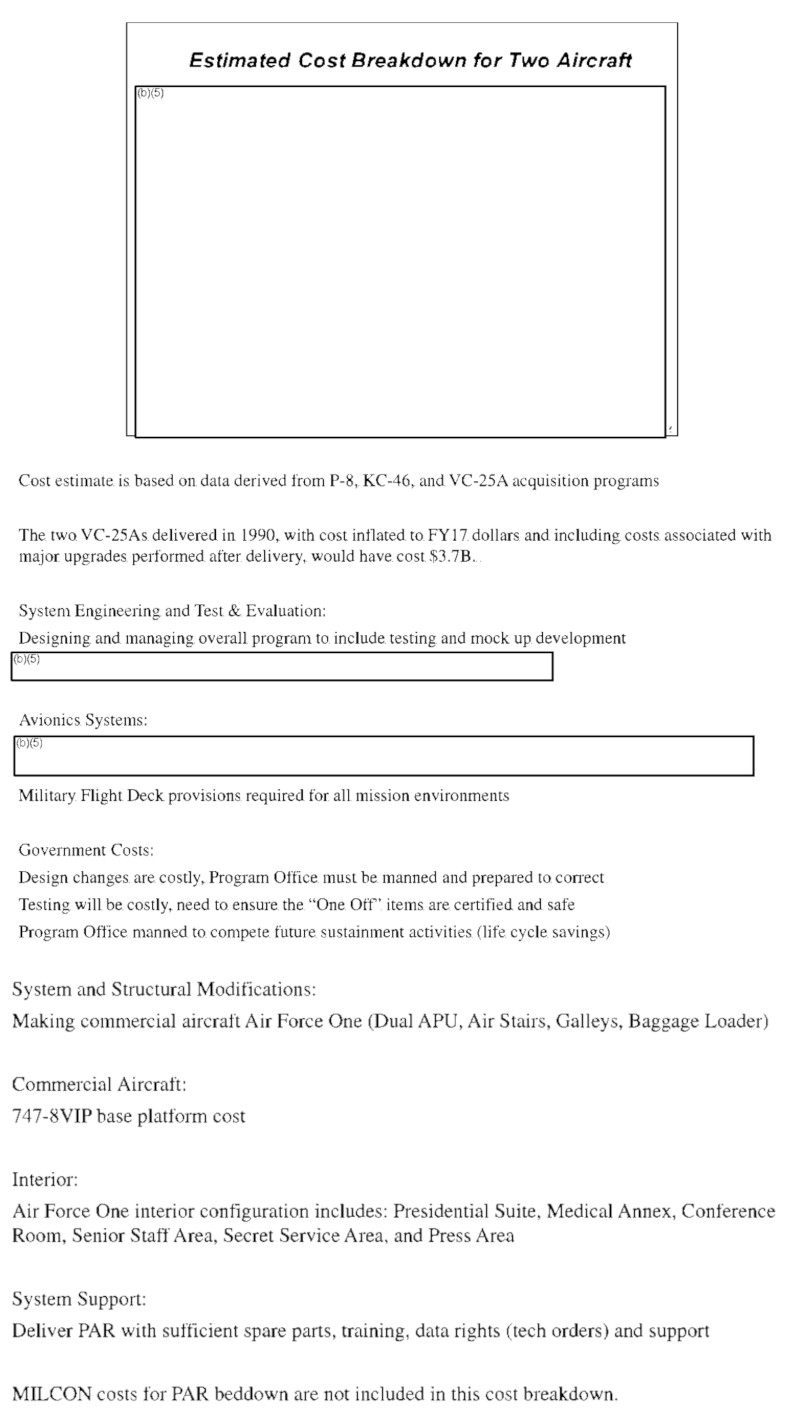
Everhart capped off the briefing with a slide highlighting the increasing age and difficulting in sustaining the existing VC-25As, necessitating a replacement. The general specifically highlighted difficulties in acquiring spare parts for the 747-200-based presidential aircraft, including an unusual note that the Air Force apparently tries to source these items anonymously in at least some cases. The most likely reason for that would be to keep the supply chain secure from hostile actors, but this would certainly add to the complexities in obtaining replacement components. More specific descriptions on the reasons for “increasing duration and cost of heavy maintenance,” are entirely redacted.
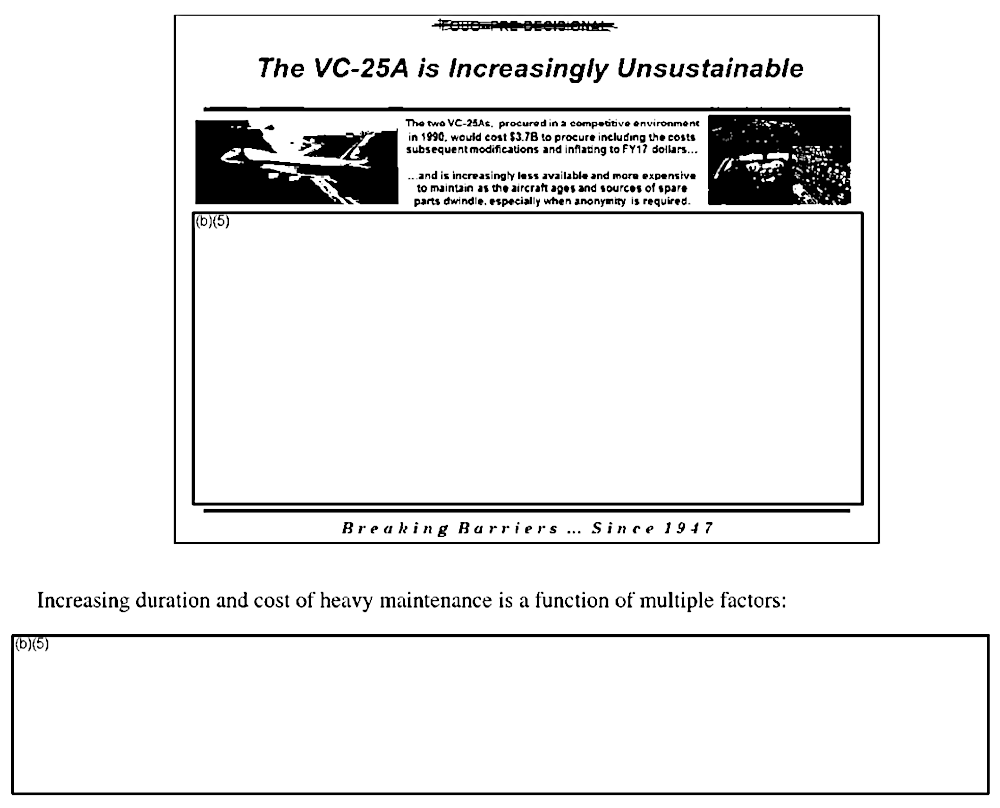
Unlike with the F-35, Trump did not issue a Tweet directly aimed the Air Force One replacement program after the briefing. It subsequently emerged that Boeing CEO Dennis Muilenburg reportedly proffered up four cost-reduction options to Trump in his own meeting with the President-Elect later on Dec. 21, 2016.
The White House subsequently said that Trump had rejected all of these proposals, but had negotiated his own deal that shaved $1 billion off the final price point. As The War Zone
noted at the time, it was unclear how or even if these savings had occurred. The latest cost information for Air Force One replacement program has only further called into question whether there have been any cuts to the program’s costs.
America’s nuclear arsenal
Previously unreported, Trump also received a very rudimentary briefing on America’s nuclear arsenal at Mar-a-Lago as part of the meetings on Dec. 21, 2016. The President-Elect had already caused a stir when he appeared to have no knowledge about the Nuclear Triad during a debate with rival Hillary Clinton during the campaign in 2015.
Lieutenant General Weinstein and U.S. Navy Vice Admiral Johnson provided an overview of the basics of the Triad in their briefing, which includes silo-based intercontinental ballistic missiles, nuclear-capable bombers, and ballistic missile submarines. It also focuses heavily on arguments for modernizing the nuclear arsenal, an effort that had begun in earnest under President Barack Obama. The briefing provided general details on the four key strategic weapons programs the U.S. military was pursuing at the time, the Ground-Based Strategic Deterrent (GBSD) ICBM, the B-21 Raider stealth bomber, the Long Range Stand-Off (LRSO) air-launched cruise missile, and the Columbia-class ballistic missile submarine, all of which are still ongoing.
You can see the slides, such as they were provided via FOIA, below:
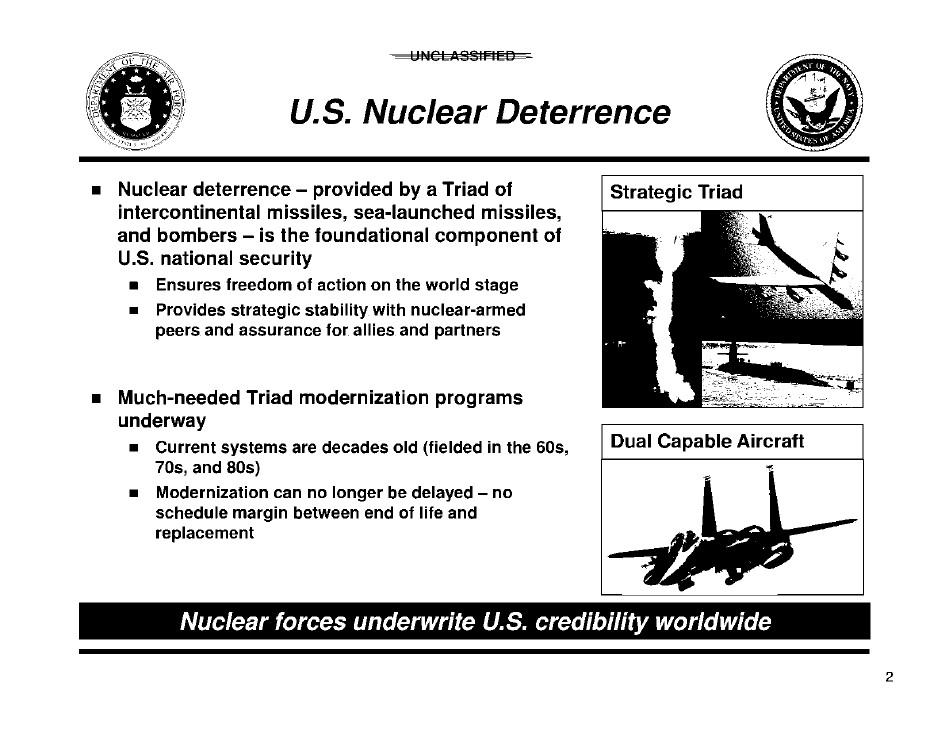
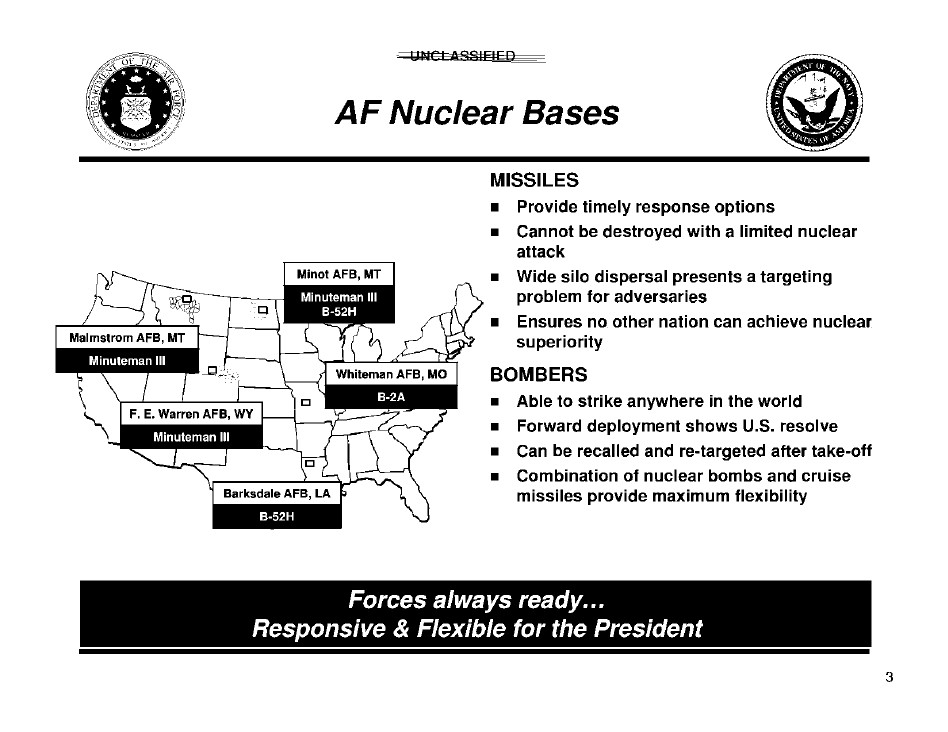

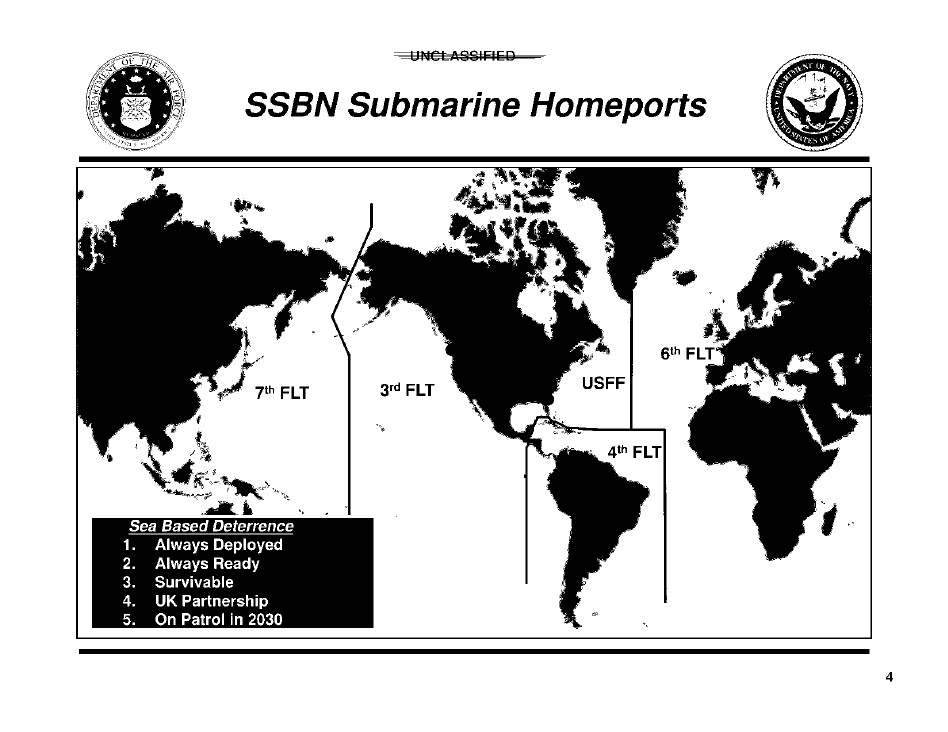
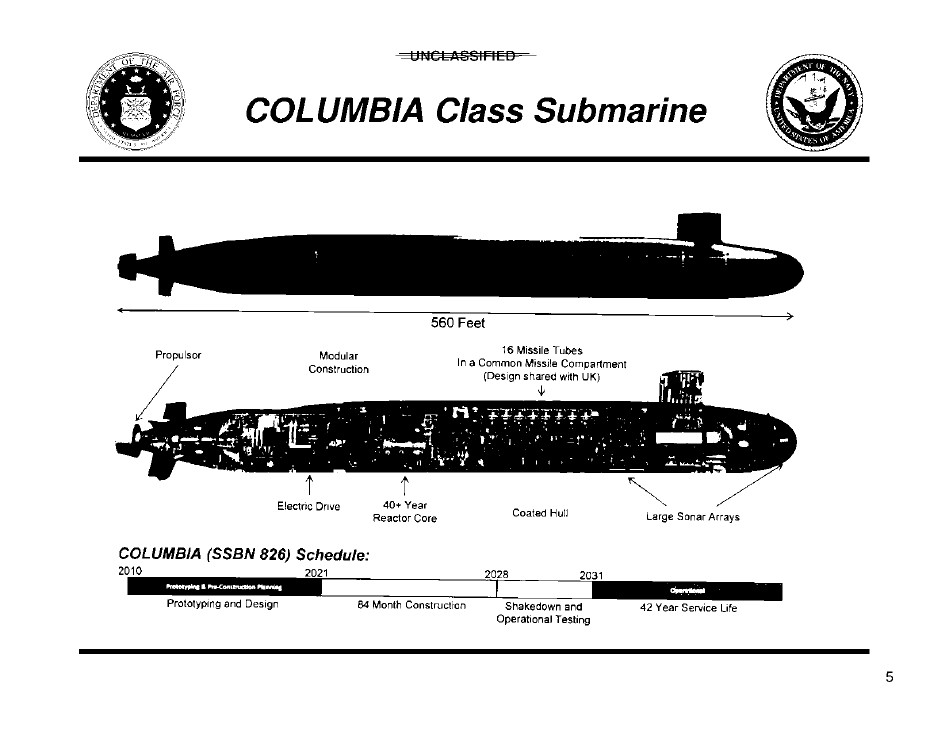
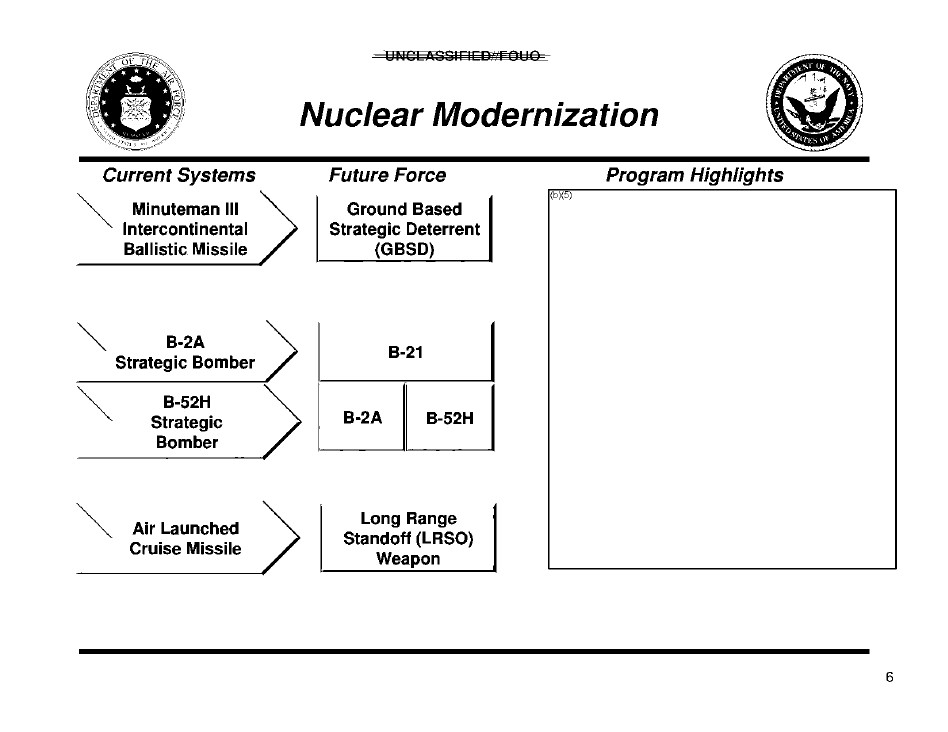
This last slide, which is a backup that Trump may not have actually seen, is interesting in that it indicates that the Air Force, at this time, intended to continue operating the B-2A Spirit stealth bomber alongside the B-21 and the B-52H. In February 2018, the Air Force revealed a new plan to outright replace B-2s, as well as the B-1s, entirely as the B-21 enters service, while retaining the B-52Hs.
This existence of this briefing explains why Trump took to Twitter on Dec. 22, 2016, to talk about modernizing America’s nuclear stockpile, which at the time seemed otherwise unprompted. “The United States must greatly strengthen and expand its nuclear capability until such time as the world comes to its senses regarding nukes,” he posted on his preferred social media platform.
A lot has changed since December 2016 in regards to all three of these topics, as well as Trump’s attitudes toward them. But being able to put Trump’s nuclear Tweet in context with an actual briefing underscores how the President’s Tweets are often linked directly to closed-door meetings he is receiving from senior officials.
These briefings also add valuable new context to the events and important details that are still relevant more than two years later, especially with regards to the capabilities and unit prices of the three F-35 variants and the exact cost of the Air Force One replacement program. Though Trump remained pugnacious on the matters of the F-35 and Air Force One immediately after the meetings at Mar-a-Lago, they appear to have served as a watershed moment in his opinions of both efforts, or the beginnings of a more active U.S. military effort, with the help of Lockheed Martin and Boeing, to craft arguments more likely to change his mind.
In February 2017, Trump claimed he had shaved $1 billion from the cost of the Air Force One program. By May 2017, the President was boasting that he had personally “straightened out” the F-35 program. In both cases, he had also adopted a much more favorable tone toward those programs.
In addition, the briefings offer a window into how the U.S. military talks to Trump, or at least did so initially. Stories over the years have highlighted the President’s apparent preference for shorter briefings with “killer graphics” – a direct quote from then-Director of the Central Intelligence Agency Mike Pompeo, who has since become Secretary of State.
The December 2016 meetings in Mar-a-Lago themselves followed a flurry of reports that the President-Elect was only taking one intelligence briefing a week, far fewer than any of his predecessors during the transition period. Trump responded to that news by saying he didn’t need daily updates because he was a “smart person.”
All told, being able to see these briefings, even in their redacted form, provide a significant new perspective on the information Trump was getting, and how he might have been digesting it, during a very important time in history.
Contact the author: jtrevithickpr@gmail.com
